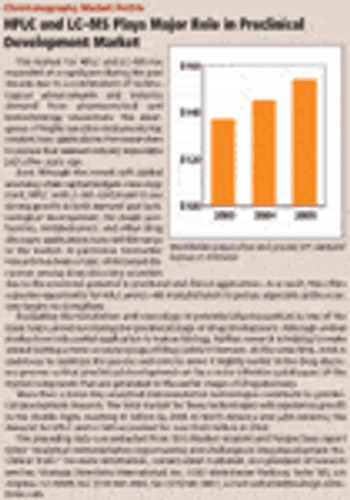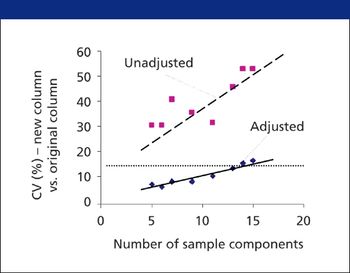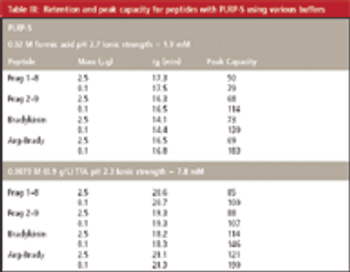
LCGC North America

LCGC North America

LCGC North America
In this initial installment of "MS - The Practical Art," a new series of columns is introduced that investigates various aspects of mass spectrometry (MS) from the perspective of some leading practitioners. Here, featured scientists Kathleen Cox and Timothy Baker discuss several MS technologies and strategies currently being applied to characterize drug candidates in early stage development.

LCGC North America
A simple HPLC procedure is described for the determination of bendroflumethiazide (BMFT) in pharmaceutical formulations and urine samples. No interferences from common additives or other drugs frequently administered with BMFT or from endogenous compounds in urine samples were found. The lack of an organic solvent in the mobile phase reduces the risk of environmental contamination and human toxicity.

LCGC North America
Liquid chromatography is a crucial process used in making a quickly expanding range of biotech products such as human insulin and cancer-fighting drugs. Located in one of the newer buildings at Pease International Tradeport (Portsmouth, New Hampshire), Euroflow represents a new breed of biotech-related companies that have emerged recently throughout the region.


LCGC North America
This month's installment of "Milestones in Chromatography" pays tribute to a true milestone in the evolution of chromatography: the introduction of the first successful GC instruments.


LCGC North America
When a column is replaced with a new or "equivalent" column, sometimes the chromatogram can change so much that it is no longer suitable for its intended use. In such cases, method adjustment is necessary to correct the change. How much can the chromatographic variables be changed before revalidation is required? What do the regulatory agencies have to say about method adjustment? The authors discuss these issues and propose a technique that can be used to speed selection of new operating conditions.

LCGC North America
A new detection method based upon aerosol charging was examined for its applicability and performance with high performance liquid chromatography (HPLC). Our results demonstrate universal detection of nonvolatile analytes with response magnitude that is independent of analyte chemical properties, four orders of magnitude dynamic range, low nanogram, lower limits of detection, and < 2% relative standard deviation response variability. Broad applicability was demonstrated for a range of methods including those using gradient elution, reversed phase, hydrophilic interaction, and ion chromatography; normal and narrow bore column formats; and in combination with other detectors (for example, UV detectors, evaporative light-scattering detectors, and mass spectrometers).

LCGC North America
Formic acid often is used for the analysis of peptides in proteomic studies by HPLC-MS, due to its volatility and reduced signal suppression. However, poorer chromatographic performance can be obtained in comparison with trifluoroacetic acid or nonvolatile phosphate buffers due to increased overloading, which can occur even for extremely small sample masses. Comparison of a highly inert silica-ODS and a wholly polymeric phase indicated that overloading effects on both are very similar and caused by the mutual repulsion of solute ions on the hydrophobic column surface.

LCGC North America
When you look at the manufacturer's literature or examine the performance sheet included with a new column, you'll see a list of column specifications, including the column plate number N. For a 5-?m particle size, column N generally will be 80,000 plates/m or more, whereas a 3-?m column will exhibit 100,000 or more theoretical plates. Your first response might be, "Get real!" After all, when real samples are analyzed on typical liquid chromatographic (LC) systems, rarely do we observe plate numbers anywhere near the manufacturer's claim.

LCGC North America
A new detection method based upon aerosol charging was examined for its applicability and performance with high performance liquid chromatography (HPLC). Our results demonstrate universal detection of nonvolatile analytes with response magnitude that is independent of analyte chemical properties, four orders of magnitude dynamic range, low nanogram, lower limits of detection, and < 2% relative standard deviation response variability. Broad applicability was demonstrated for a range of methods including those using gradient elution, reversed phase, hydrophilic interaction, and ion chromatography; normal and narrow bore column formats; and in combination with other detectors (for example, UV detectors, evaporative light-scattering detectors, and mass spectrometers).